
The Book of Kells is an illuminated manuscript and Celtic Gospel book in Latin, containing the four Gospels of the New Testament together with various prefatory texts and tables. It was created in a Columban monastery in either Ireland or Scotland, and may have had contributions from various Columban institutions from each of these areas. It is believed to have been created c. 800 AD. The text of the Gospels is largely drawn from the Vulgate, although it also includes several passages drawn from the earlier versions of the Bible known as the Vetus Latina. It is regarded as a masterwork of Western calligraphy and the pinnacle of Insular illumination. The manuscript takes its name from the Abbey of Kells, County Meath, which was its home for centuries.

The Codex Argenteus is a 6th-century illuminated manuscript, originally containing part of the 4th-century translation of the Christian Bible into the Gothic language. Traditionally ascribed to the Arian bishop Wulfila, it is now established that the Gothic translation was performed by several scholars, possibly under Wulfila's supervision. Of the original 336 folios, 188—including the Speyer fragment discovered in 1970—have been preserved, containing the translation of the greater part of the four canonical gospels. A part of it is on permanent display at the Carolina Rediviva building in Uppsala, Sweden, under the name "Silverbibeln".

The Codex Aureus of St. Emmeram is a 9th-century illuminated Gospel Book. It takes its name from Saint Emmeram's Abbey, where it was for most of its history and is lavishly illuminated. The cover of the codex is decorated with gems and relief figures in gold, and can be precisely dated to 870, and is an important example of Carolingian art, as well as one of very few surviving treasure bindings of this date.
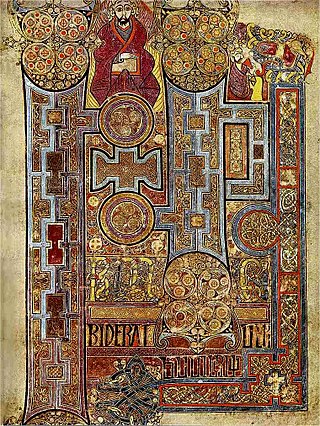
A Gospel Book, Evangelion, or Book of the Gospels is a codex or bound volume containing one or more of the four Gospels of the Christian New Testament – normally all four – centering on the life of Jesus of Nazareth and the roots of the Christian faith. The term is also used for a liturgical book, also called the Evangeliary, from which are read the portions of the Gospels used in the Mass and other services, arranged according to the order of the liturgical calendar.
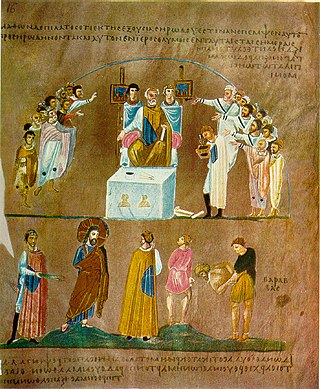
The Rossano Gospels, designated by 042 or Σ, ε 18 (Soden), held at the cathedral of Rossano in Italy, is a 6th-century illuminated manuscript Gospel Book written following the reconquest of the Italian peninsula by the Byzantine Empire. Also known as Codex purpureus Rossanensis due to the reddish-purple appearance of its pages, the codex is one of the oldest surviving illuminated manuscripts of the New Testament. The manuscript is famous for its prefatory cycle of miniatures of subjects from the Life of Christ, arranged in two tiers on the page, sometimes with small Old Testament prophet portraits below, prefiguring and pointing up to events described in the New Testament scene above.

The Rabbula Gospels, or Rabula Gospels, is a 6th-century illuminated Syriac Gospel Book. One of the finest Byzantine works produced in West Asia, and one of the earliest Christian manuscripts with large miniatures, it is distinguished by the miniaturist's predilection for bright colours, movement, drama, and expressionism. Created during a period from which little art survived, it nevertheless saw great development in Christian iconography. The manuscript has a significant place in art history, and is very often referred to.
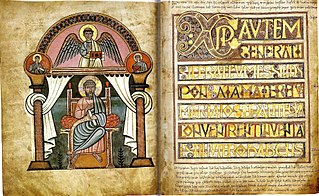
The Stockholm Codex Aureus is a Gospel book written in the mid-eighth century in Southumbria, probably in Canterbury, whose decoration combines Insular and Italian elements. Southumbria produced a number of important illuminated manuscripts during the eighth and early ninth centuries, including the Vespasian Psalter, the Stockholm Codex Aureus, three Mercian prayer books, the Tiberius Bede and the British Library's Royal Bible.
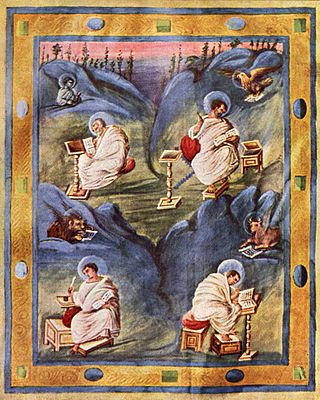
Carolingian art comes from the Frankish Empire in the period of roughly 120 years from about 780 to 900—during the reign of Charlemagne and his immediate heirs—popularly known as the Carolingian Renaissance. The art was produced by and for the court circle and a group of important monasteries under Imperial patronage; survivals from outside this charmed circle show a considerable drop in quality of workmanship and sophistication of design. The art was produced in several centres in what are now France, Germany, Austria, northern Italy and the Low Countries, and received considerable influence, via continental mission centres, from the Insular art of the British Isles, as well as a number of Byzantine artists who appear to have been resident in Carolingian centres.

Ottonian art is a style in pre-romanesque German art, covering also some works from the Low Countries, northern Italy and eastern France. It was named by the art historian Hubert Janitschek after the Ottonian dynasty which ruled Germany and Northern Italy between 919 and 1024 under the kings Henry I, Otto I, Otto II, Otto III and Henry II. With Ottonian architecture, it is a key component of the Ottonian Renaissance. However, the style neither began nor ended to neatly coincide with the rule of the dynasty. It emerged some decades into their rule and persisted past the Ottonian emperors into the reigns of the early Salian dynasty, which lacks an artistic "style label" of its own. In the traditional scheme of art history, Ottonian art follows Carolingian art and precedes Romanesque art, though the transitions at both ends of the period are gradual rather than sudden. Like the former and unlike the latter, it was very largely a style restricted to a few of the small cities of the period, and important monasteries, as well as the court circles of the emperor and his leading vassals.

British Library, Egerton MS 609 is a Breton Gospel Book from the late or third quarter of the ninth century. It was created in France, though the exact location is unknown. The large decorative letters which form the beginning of each Gospel are similar to the letters found in Carolingian manuscripts, but the decoration of these letters is closer to that found in insular manuscripts, such as the Book of Kells and the Lindisfarne Gospels. However, the decoration in the Breton Gospel Book is simpler and more geometric in form than that found in the Insular manuscripts. The manuscript contains the Latin text of St Jerome's letter to Pope Damasus, St. Jerome's commentary on Matthew, and the four Gospels, along with prefatory material and canon tables. This manuscript is part of the Egerton Collection in the British Library.

The Bible of San Paolo fuori le Mura is a 9th-century illuminated Bible. Of all surviving Carolingian Bibles, it is the most thoroughly illuminated.
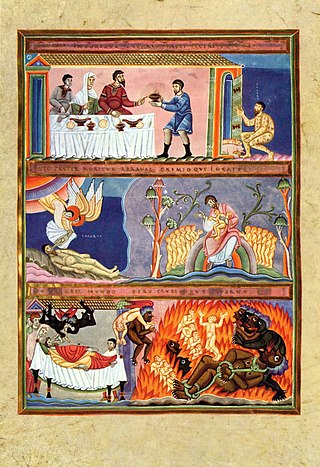
The Codex Aureus of Echternach is an illuminated Gospel Book, created in the approximate period 1030–1050, with a re-used front cover from around the 980s. It is now in the Germanisches Nationalmuseum in Nuremberg.
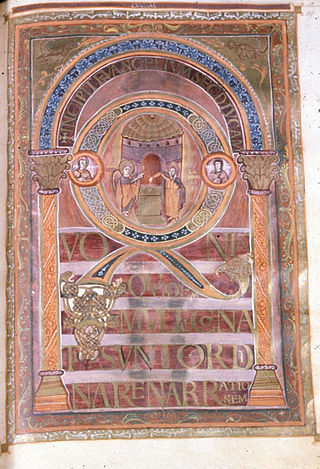
The Harley Golden Gospels, British Library, Harley MS 2788, is a Carolingian illuminated manuscript Gospel book produced in about 800–825, probably in Aachen, Germany. It is one of the manuscripts attributed to the "Ada School", which is named after the Ada Gospels. It has four pairs of full-page Evangelist portraits and illuminated "Incipit" pages, canon tables, and other illuminations. As with other examples of the Codex Aureus, the text is written in gold ink.

The Aachen Gospels are a Carolingian illuminated manuscript which was created at the beginning of the ninth century by a member of the Ada School. The Evangeliary belongs to a manuscript group which is referred to as the Ada Group or Group of the Vienna Coronation Gospels. It is part of the church treasury of Charlemagne's Palatine Chapel, now Aachen Cathedral, and is today kept in the Aachen Cathedral Treasury. The Treasury Gospels and the more recent Ottonian Liuthar Gospels are the two most significant medieval manuscripts on display there.

The Sacramentary of Henry II, also called the Regensburg Sacramentary, is a manuscript of liturgical texts, which was created in Regensburg at the order of Emperor Henry II. It is among the most significant works of Ottonian illumination. The manuscript was gifted to Bamberg Cathedral by Henry II, was part of the Cathedral treasury until 1803 when it became part of the Bavarian State Library as a result of Secularisation. It remains there today, stored under the inventory number clm 4456. It is modelled on the Codex Aureus of St. Emmeram donated by Charles the Bald in 870.
The Sainte-Chapelle Gospels or the Sainte-Chapelle Gospel Book is an Ottonian illuminated manuscript now housed in the Bibliothèque nationale de France in Paris as Latin 8851. It is made up of 156 parchment folios, in a 38.5 cm by 28 cm format, making it one of the largest manuscripts of its era. It includes miniatures such as the canon tables, Christ in majesty and the Four Evangelists. It is the work of the Master of the Registrum Gregorii, the most famous illuminator of the Ottonian Renaissance.
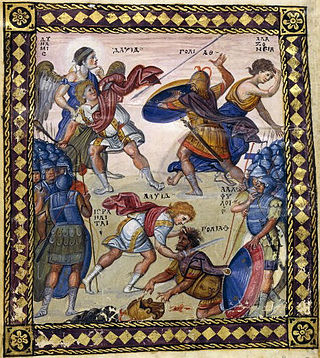
Byzantine illuminated manuscripts were produced across the Byzantine Empire, some in monasteries but others in imperial or commercial workshops. Religious images or icons were made in Byzantine art in many different media: mosaics, paintings, small statues and illuminated manuscripts. Monasteries produced many of the illuminated manuscripts devoted to religious works using the illustrations to highlight specific parts of text, a saints' martyrdom for example, while others were used for devotional purposes similar to icons. These religious manuscripts were most commissioned by patrons and were used for private worship but also gifted to churches to be used in services.

The Emperor's Bible, also known as Codex Caesareus, Codex Caesareus Upsaliensis or the Goslar Gospels, is an 11th-century illuminated manuscript currently in Uppsala University Library, Sweden. Despite its name, it is not a Bible but a Gospel Book. The book was made in the scriptorium of Echternach Abbey in Luxembourg, and is one of four preserved large Gospel Books made there during the 11th century. It was commissioned by Emperor Henry III and donated by him to Goslar Cathedral in Germany, where it remained until the Thirty Years' War (1618-1648). It was then lost for about 100 years. Its previous richly-decorated cover was also lost at this time at the latest. The book later appeared again in the possession of Swedish diplomat and civil servant Gustaf Celsing the Elder. At the death of his son, it was acquired by Uppsala University.

The Spanish illumination of the Early Middle Ages is the art of decorating books that developed in Spain from the 8th to the 11th. The country was marked by the Muslim occupation from 711, which tended to isolate it from the rest of Europe. In the regions that remained Christian, first in the Kingdom of Asturias and then in León, an original art was invented in monasteries, mixing Visigothic, Carolingian, and also Moorish influences.

















